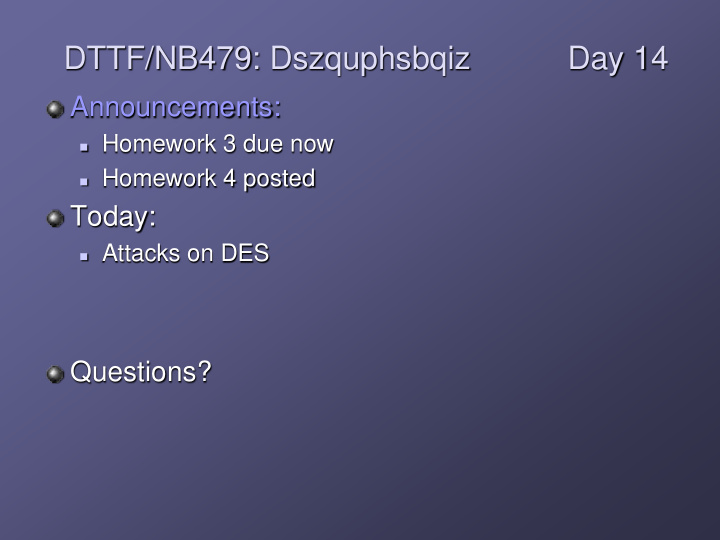



DTTF/NB479: Dszquphsbqiz Day 14 Announcements: Homework 3 due now Homework 4 posted Today: Attacks on DES Questions?
DES has been showing signs of weakness from the beginning 1975 1987 1993 2000 2013 1977 1992
Only 2 56 = 72,057,594,037,927,936 keys, so it was brute forced using parallelism 1997: DES Challenge issued. $10K prize Found after 5 months, searching ___% of keyspace 1998: DES Challenge II Down to 39 days, 85% of keyspace! Also in 1998…
DES Cracker used a mixture of software and specialized hardware Budget of only $200,000 1998 dollars vs $20,000,000 1977 dollars Result?
Post-DES Brute force attacks that take O(N) DES computations are now reasonable. N is size of keyspace = 2 56 Can we just double encrypt to get O(N 2 ) computations? Use k1, k2 C = E k2 (E k1 (P)), so P = D k1 (D k2 (C)) ?
Meet-in-the-middle attack Assume k completely determines E k and D k Know P and C = E k2 (E k1 (P)) E k1 (P) D k2 (C) (for all (for all C P k1) k2) Time complexity? O( n ) DES computations, O( n 2 ) comparisons O(n ) memory
Triple-DES? Comparisons Memory Brute Type DES force computations DES O(N 2 ) O(N) O(N 2 ) Double O(N) C=E k2 (E k1 (P)) Triple1 C=E k3 (E k2 (E k1 (P))) Triple2 C=E k1 (E k2 (E k1 (P))) Triple3 C=E k2 (E k1 (E k1 (P))) Describe attacks on triple 1-3, fill out chart, and order by level of security
Triple-DES? Comparisons Memory Brute Type DES force computations DES O(N 2 ) O(N) O(N 2 ) (3) Double O(N) C=E k2 (E k1 (P)) O(N 2 ) O(N 3 ) O(N 2 ) O(N 3 ) (1) Triple1 C=E k3 (E k2 (E k1 (P))) (2) Triple2 C=E k1 (E k2 (E k1 (P))) (3) Triple3 C=E k2 (E k1 (E k1 (P))) Describe attacks on triple 1-3, fill out chart, and order by level of security
Triple-DES? Comparisons Memory Brute Type DES force computations DES O(N 2 ) O(N) O(N 2 ) (3) Double O(N) C=E k2 (E k1 (P)) O(N 2 ) O(N 3 ) O(N 2 ) O(N 3 ) (1) Triple1 C=E k3 (E k2 (E k1 (P))) O(N 2 ) O(N 3 ) O(N 2 ) O(N 2 ) (2) Triple2 C=E k1 (E k2 (E k1 (P))) (3) Triple3 C=E k2 (E k1 (E k1 (P))) Describe attacks on triple 1-3, fill out chart, and order by level of security
Triple-DES? Comparisons Memory Brute Type DES force computations DES O(N 2 ) O(N) O(N 2 ) (3) Double O(N) C=E k2 (E k1 (P)) O(N 2 ) O(N 3 ) O(N 2 ) O(N 3 ) (1) Triple1 C=E k3 (E k2 (E k1 (P))) O(N 2 ) O(N 2 ) O(N 2 ) O(N 2 ) (2) Triple2 C=E k1 (E k2 (E k1 (P))) O(N 2 ) O(N) O(N 2 ) (3) Triple3 O(N) C=E k2 (E k1 (E k1 (P))) Describe attacks on triple 1-3, fill out chart, and order by level of security
DES Modes of Operation Electronic codebook: Each block is encoded independently Text ASCII bit vector Block 1 (64 bits) Block 2 (64 bits) DES DES … Encoded 1 (64 bits) Encoded 2 (64 bits) Encoded bit vector
DES Modes of Operation Cipher-block chaining: Each plaintext block is XOR’ed with the previous ciphertext before going into DES We will do a simpler version of this in HW4 (set C 0 = 0) Text ASCII bit vector Block 1 (64 bits) Block 2 (64 bits) C 0 DES + DES + … + (random; Encoded 1 (64 bits) sent in Encoded 2 (64 bits) clear) Encoded bit vector
DES Modes of Operation Others: Cipher feedback: similar, but 64-bit blocks overlap, giving k bits at a time (like 8 for 1 character at a time) Uses pseudorandom bits like LFSR Output feedback: similar but helps catch errors before propagate. Counter : Some output can be computed independently, so better for parallelizing I trust you could implement these if needed. Not part of HW4…
HW4: DES Implementation Encryption and decryption. Cipher-block chaining to prevent speedups due to embarrassing parallelism Correctness: Can use one to test the other. Efficiency: In addition, it’d be nice to use a language that’s closer to the hardware for efficiency, like C or non-OO Java. Part of your grade will depend on this There will also be a competition to see whose implementation is quickest!
Questions so far on DES?
Recommend
More recommend